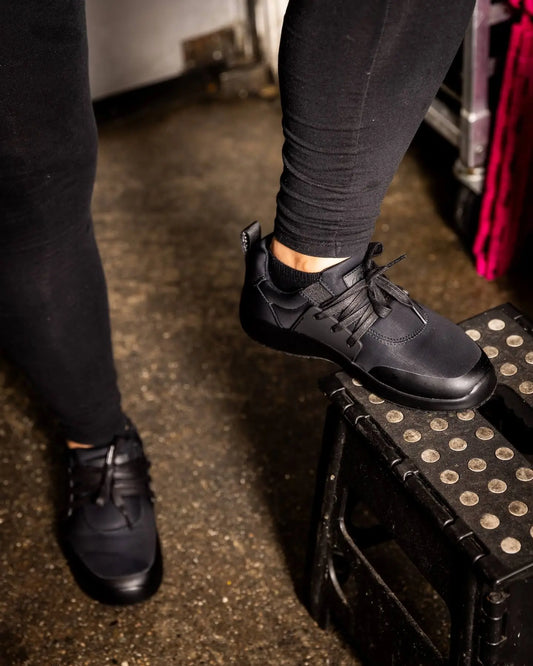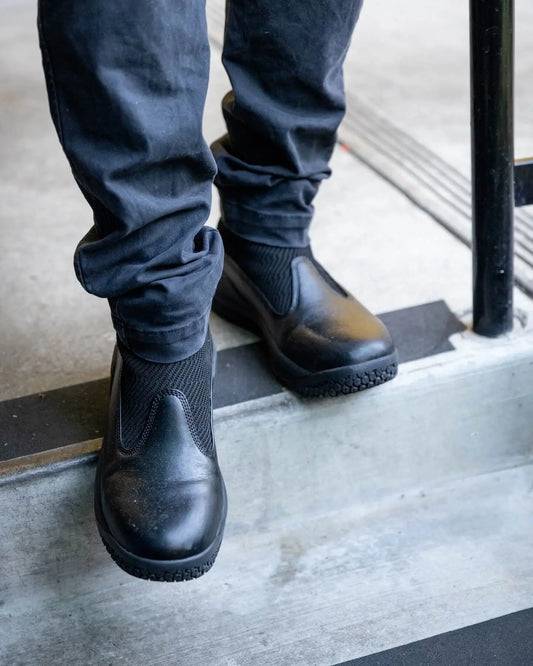Most Common Restaurant Injuries
Alex Kinejara
Nimbly navigating treacherous terrain. Skirting slippery spills and dodging obstacles (and sometimes your co-workers). Lifting heavy objects and carrying them far distances, all while evading open flames, hot liquids, and a host of other hazards. You might not list these skills on your resume, but if you’re in food service, they’re definitely in your toolbox.
The fact is, restaurants can be dangerous places. From slick surfaces and sharp objects to sizzling grills and careening coworkers, there are a lot of ways you can get hurt while on the job.
Fortunately, there are a handful of steps you can take to protect yourself and others on the job. Keep reading to learn about the four most common restaurant injuries and how to avoid them with simple solutions such as safe restaurant shoes.
#1 Laceration Nation
Among the most common restaurant injuries are lacerations like cuts, scrapes, and puncture wounds.1 From sharp knives and slicers to broken glasses and plates, restaurants and kitchens are full of sharp edges that can cause injury.
Laceration injuries may be a hazard of the trade, but they aren’t completely unavoidable. You can minimize your risk and your co-workers’ risk of injury (and make sure only the vegetables are getting sliced and diced) by:
- Immediately cleaning up broken glass and disposing of it safely
- Exercising caution when using and cleaning sharp kitchen tools
- Storing sharp tools safely
While preventing a workplace accident is the main concern, it's just as important to know how to treat these common injuries if they do occur.
#2 Strains, Sprains, and Muscle Pains
Restaurants are full of commotion, especially during peak hours. Servers flying in every direction, doors swinging open and closed, sight lines perpetually obscured by trays piled with dishes—it doesn’t take much for things to get wild behind the scenes. With all this commotion, it’s no surprise that restaurant workers are prone to a workplace injury or related severe foot problems.
Often, strains, sprains, and muscle injuries are the result of intramural collisions, so be diligent about following your workplace’s safety standards and protocols, like calling corners and using dedicated in/out doors to cut back on crashes in the kitchen.
Other common restaurant injuries of the strain, sprain, and muscle pain variety include:
#3 Feel the Burn
According to the CDC, workplace burns are the most common type of occupational injury, across industries.3 In the restaurant industry, burn injuries are often the result of coming into contact with:
- Hot surfaces
- Boiling water
- Hot liquids like grease and oil
As a food service worker that’s prone to a burn injury, it’s important to exercise tremendous caution when you’re working around ovens, grills, hot pans, pots, and fryers. Pants and long sleeves can help protect your skin from flying grease and oil, and wearing the proper shoes can protect your feet from hot spills.
#4 Eye Injuries
Rounding out the list of the most common restaurant injuries are eye injuries. Aside from the risk of puncture that’s present whenever you have a lot of people moving around in a small space, restaurant eye injuries also occur from:
- Splashed grease or oil
- Cleaning agents
- Sanitizing chemicals
To minimize the damage these injuries can cause, it’s important to treat them right away. For that reason, you should familiarize yourself with the location and contents of your restaurant’s first-aid kit so you know how to respond when you or a co-worker is injured.
Although a work injury is not 100% preventable, one of the most important things a restaurant worker can do is follow restaurant safety tips and procedures to stay safe.
Snibbs: Safety That Doesn’t Sacrifice Style
According to the CDC, slips, trips, and falls were the cause of 27% of workplace injuries in 2019.4 Although there are many factors that can contribute to workplace safety, it’s reasonable to assume that a good number of those slip injuries could have been prevented by non-slip shoes.
Meet Snibbs. We’re making restaurants everywhere safer with our collections of slip-resistant shoes. Our shoes feature durable rubber outsoles that are certified by the Brungraber Mark II Test, the industry standard when it comes to slip-resistance—guaranteeing superior slip protection, whether you’re traipsing through water, grease, oil, or any other kind of spill.
When you shop Snibbs, you know you’re getting workplace-safe shoes made from the highest quality materials, plus top-of-the-line orthopedic features and ergonomic designs that don’t sacrifice style in the name of safety. Fashionable, functional, and safe—if you aren’t in Snibbs, you aren’t doing right by your feet.
Shop non-slip shoes today and discover the difference a pair of Snibbs can make.
Sources:
- AMTrust Financial. Food Service Workplace Injuries. https://amtrustfinancial.com/blog/loss-control/reducing-the-risk-of-restaurant-workers-injuries#
- Mayo Clinic. Proper Lifting Techniques. https://www.mayoclinic.org/healthy-lifestyle/adult-health/multimedia/back-pain/sls-20076866
- CDC. Occupational Burns Among Workers. https://www.cdc.gov/mmwr/preview/mmwrhtml/00021845.htm
- CDC. Traumatic Occupational Injuries. https://www.cdc.gov/niosh/injury/fastfacts.html














